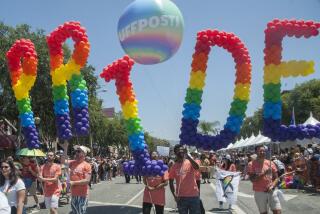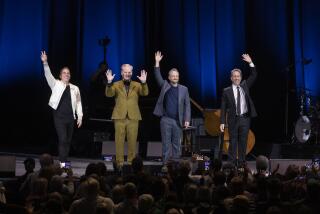Stand-Up Poets Rhyme for Laughs
The reading was anything but staid. Offering smiles in a tiny cafe in Los Angeles, with pillows on the floor and strobe lights in the corridors, five poets raised their voices in dramatic renditions of their works to an audience favoring black sweaters and oddly colored hairdos.
âThe ocean is forever changing its clothes to be more beautiful for you,â Ron Koertge read from a poem called âRedondo.â
Wanda Coleman read from a work titled âI Live for My Car.â âCanât let go of it,â she said. âTo live is to drive.â
The audience, in stark contrast to the prevailing image of the polite etiquette required at poetry readings, responded with loud guffaws, chortles, cheers and applause.
Such readings have been going on for several years in Southern California. Now a Cal State Long Beach professor has decided to give them a name. The readings and the art they feature, says Charles H. Webb, are stand-up poetry. âItâs an incredible phenomenon,â said Webb, who teaches English. âItâs a legitimate, important voice. It has a sassy, youthful, irreverent vitality that seems very L.A.â
To prove his point, Webb recently published an anthology called âStand Up Poetryâ featuring the work of more than 20 poets including himself. The importance of the book, he said, is that it represents the first time that some key poems have been collected and an attempt made to explore what they have in common.
Webb also organized a series of readings--including one next Tuesday at The Improvisation, a Santa Monica nightclub ordinarily associated with comedy--to highlight the stand-up phenomenon and further demonstrate his contention that poetry can be fun.
It is not the first time, of course, that poets have stood up in public to recite their works to demonstrative audiences. In the 1950s, for instance, beatniks made something of a ritual of cafe poetry readings backed up by jazz. And 20 years later, Los Angeles poet and novelist Charles Bukowski--whose life was later celebrated in the movie âBarflyâ--became famous for his gutsy readings during which he was reputed to frequently swill beer.
In fact, Webb said, many of todayâs stand-up poets trace their literary roots to the beatniks and were greatly influenced by Bukowski. The term âstand-up poetryâ was coined by two other CSULB professor-poets, Gerald Locklin and Charles Stetler.
They used it to describe the work of fellow poet Edward Field, according to Webb. In a lecture last year at CSULB, Webb expanded the term to include the large group of Los Angeles-area poets he considers of the same school. Later he published an essay in a literary journal examining the work of five stand-up poets, including Field and Locklin, and generally describing the characteristics of the genre. And late last month he brought out the anthology, published by a literary collective called Red Wind Books.
âI think itâs a useful appellation for what this cluster of poets is trying to do,â said Robert Peters, a professor of English at UC Irvine who is a noted critic and poet and has written more than 30 books. âItâs talk poetry.â
Among the characteristics common to most stand-up poetry, according to Webb, is clarity, humor, natural-sounding language, performability, the use of fancy and a strong individual voice. Like the best modern fiction, he said, it often tells a story, has no taboos regarding subject matter and frequently makes use of images from urban and pop culture.
Because so many of the stand-up poets live in or near Los Angeles, Webb said, much of their work deals with familiar elements of life in the city such as automobiles, pollution and the ocean. Indeed, the poets say, it is the areaâs long association with the movie and entertainment industries that has given stand-up poetry its strong performance orientation.
âL.A. is the only city in the shadow of Hollywood,â said Suzanne Lummis, who co-edited the stand-up anthology with Webb and is an accomplished poet in her own right. âPerformance therefore becomes a quality that affects all of the other arts.â
âIf youâre going to be on stage with actors,â said Webb, alluding to the fact that many stand-up poets have backgrounds in acting, âyou better perform well or youâll be dwarfed.â
Peters, for one, says he does not believe that this latest wrinkle in poetic history will have a lasting effect on the larger field.
âTheyâre not experimenting, really, with form,â he said. âWhere their contribution lies is in the energy they bring to the writing scene here. I think theyâre just making a lot more visible in public whatâs gone on in Southern California since the days of the beats. Itâs not new, but itâs vigorous and it will probably end up getting more readers for poetry.â
The vigor, at least, seemed evident during the recent reading at Mad Hatter, a bohemian-looking cafe on Pico Boulevard.
âI like my own poems best . . . ,â Webb read from a poem by Jack Grapes. âHow those lines sing! All that wisdom and beauty! . . . I mean, I understand what the hell the damn poetâs talking about . . . .â
After the laughter died down, some members of the audience expressed their appreciation with praise and applause.
âI find the phenomenon exciting,â said Lisa Rafel of Malibu. âIt doesnât just come from the poets, it comes from the audience responding. I thought this was a tremendous amount of fun.â
More to Read
Sign up for our Book Club newsletter
Get the latest news, events and more from the Los Angeles Times Book Club, and help us get L.A. reading and talking.
You may occasionally receive promotional content from the Los Angeles Times.







